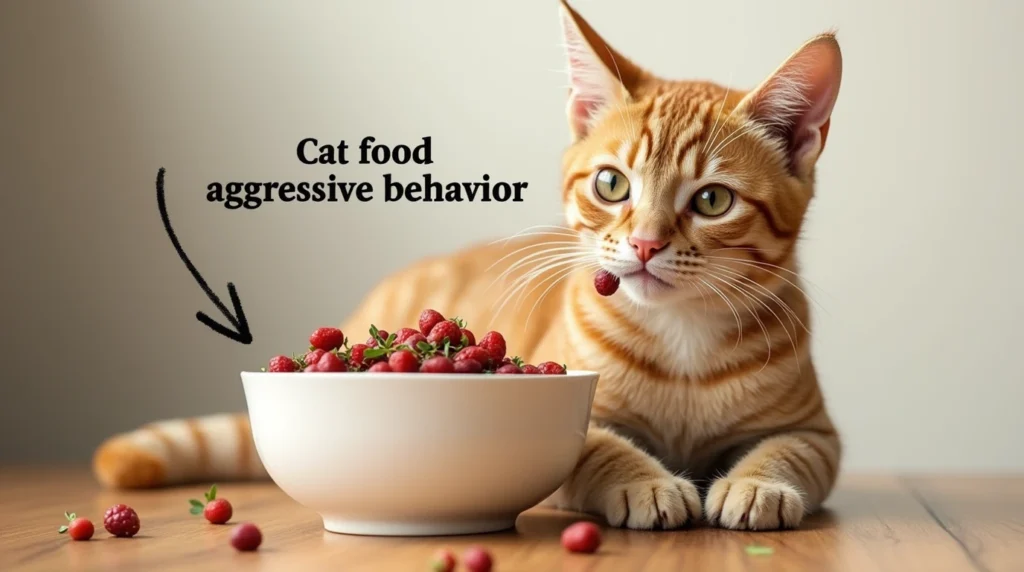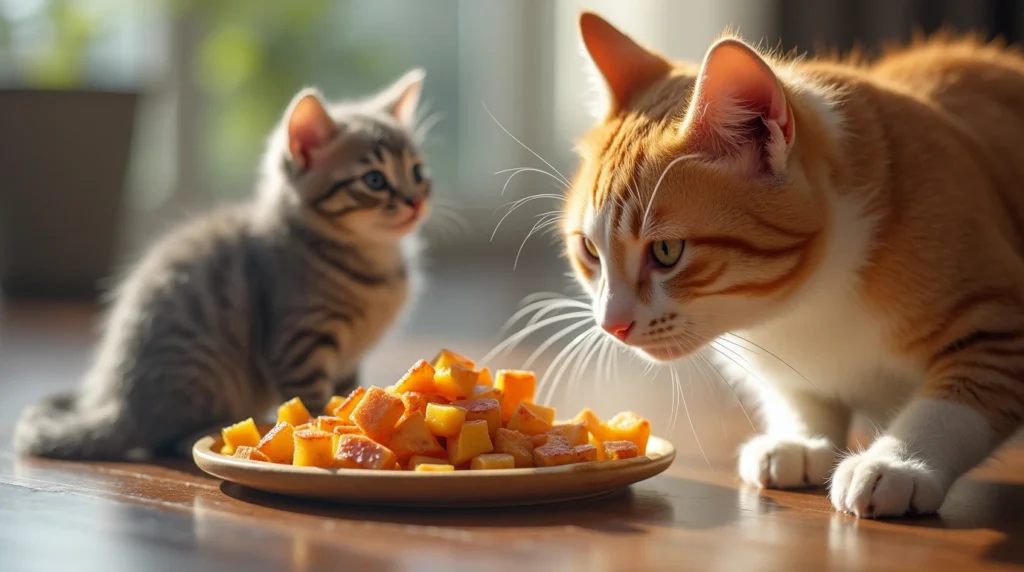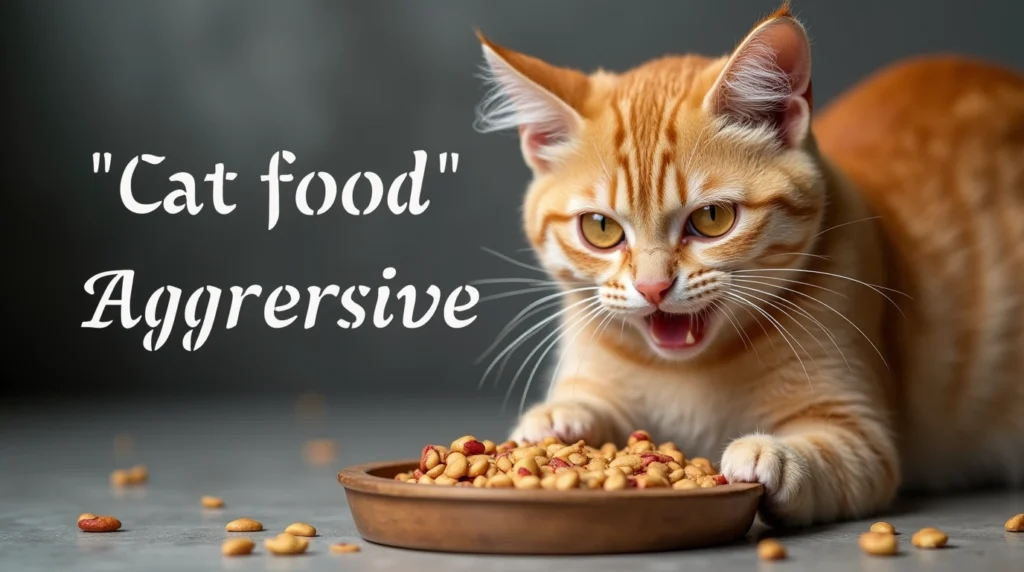Have you ever been shocked by your cat’s behavior at mealtime? Maybe you’ve noticed them growling, hissing, or swatting at you when you get too close to their food. It’s a concerning and often puzzling situation. After all, you love your cat, and the last thing you expect is to be met with a defensive, sometimes hostile attitude when trying to feed them.
Food aggression in cats can feel like a mystery, but understanding its root causes can help you tackle the issue effectively. Whether your cat’s behavior stems from territorial instincts, anxiety, or previous experiences of food scarcity, this article will guide you through understanding and addressing aggressive cat behavior around food. By the end of it, you’ll have a clearer picture of why your cat acts this way and how to manage it.
Table of Contents
What to Expect in This Article: cat food aggressive behavior

- What food aggression in cats really means
- The possible reasons behind your cat’s aggressive behavior
- Practical solutions to reduce or eliminate this behavior
- How to improve your relationship with your cat during mealtime
So, let’s dive in and unravel the mystery behind why your cat acts aggressively with food.
What Is Food Aggression in Cats?
Food aggression refers to a cat’s hostile or defensive behavior in the presence of food. This can include growling, hissing, swatting, or even guarding the food bowl. Cats are territorial creatures by nature, and many of their instincts, especially regarding food, are linked to survival and resource protection.
Common Signs of Food Aggression: cat food aggressive behavior
- Growling or Hissing: If your cat growls or hisses when you approach their food bowl, it’s a clear sign of food aggression.
- Swatting or Biting: Some cats may physically swat or bite to protect their food from perceived threats.
- Eating Quickly and Aggressively: A cat who inhales their food quickly and acts possessive over it is exhibiting signs of food aggression.
- Guarding the Food Bowl: Some cats refuse to let anyone come near their food, even if it’s a family member or another pet.
Understanding these signs is the first step toward identifying food aggression in your cat. But why do they behave this way? Let’s take a closer look at the potential causes.
Why Is My Cat So Aggressive About Food? Uncovering the Root Causes
Territorial Instincts and Food / cat food aggressive behavior
Cats are solitary hunters by nature, and their instinct to protect their territory is deeply ingrained. In the wild, a cat might have to defend its food from other animals to ensure survival. This territorial behavior often carries over into domestic settings, leading your cat to view their food bowl as part of their personal territory.
When your cat exhibits food aggression, they may be reacting to an innate desire to protect what they consider “theirs.” This is especially true if they feel that other pets, humans, or outside animals are intruding on their space.
Hunger or Scarcity Mindset
Cats who have experienced periods of food scarcity may be more prone to food aggression. If your cat was rescued or had to fend for themselves on the streets, they might have developed an intense attachment to food as a survival mechanism. This can manifest as possessiveness or aggression when they’re eating, fearing that food may not always be available.
If you’ve adopted a rescue cat or one who has had a history of inadequate food, their aggressive behavior could be rooted in this sense of insecurity.
Fear of Competition
If your home has multiple pets, particularly other cats or dogs, your cat might become protective of their food due to fear of competition. They may perceive other animals as threats to their resources, which triggers defensive behavior.
Cats are territorial animals, and competition for food can heighten their instinct to guard it. This often leads to aggression during feeding times, as your cat tries to ward off rivals.
Medical Issues Contributing to Aggression / cat food aggressive behavior
Sometimes, aggression around food can be a symptom of an underlying health issue. Cats that experience pain or discomfort while eating might exhibit hostile behavior as a response to the discomfort. For example, dental problems, such as gum disease or tooth pain, can make eating painful. Similarly, gastrointestinal issues might cause a cat to become irritable during mealtimes.
If your cat’s aggressive behavior around food is a recent development or seems to be getting worse, it’s worth considering a trip to the vet to rule out any health issues.
How to Manage and Prevent Food Aggression in Cats
Understanding why your cat is displaying aggressive behavior around food is the first step. Now let’s look at some strategies you can implement to reduce or eliminate this behavior.
Create a Safe Eating Environment / cat food aggressive behavior
Feeding in a Quiet Area
A common solution to food aggression is to provide your cat with a calm, private space to eat. Cats are sensitive creatures, and feeding them in a busy or noisy area can cause anxiety and trigger food aggression. Choose a quiet corner or room where they can eat without distractions.
Separate Feeding Areas for Multiple Pets
If you have more than one pet, it’s essential to provide each animal with its own feeding area. This will reduce competition and allow each cat to feel secure while eating. Feeding stations should be spaced out to avoid conflict.
Positive Reinforcement and Behavioral Training
Gradually Desensitize to the Presence of People and Other Pets
One of the most effective ways to address food aggression is to gradually desensitize your cat to the presence of others during mealtime. Start by slowly approaching their food bowl while they are eating, but don’t interfere. As they get used to your presence, reward them with treats or praise when they remain calm. Over time, your cat will associate your presence with positive experiences rather than stress.
Consult with a Behaviorist
If the food aggression persists despite your best efforts, you may want to seek the help of a professional animal behaviorist. They can help you develop a customized plan for addressing the aggression and offer advice specific to your cat’s behavior.
Adjust Feeding Practices /cat food aggressive behavior
Scheduled Feedings
Cats thrive on routine, and scheduled feedings can help reduce food-related anxiety. By offering meals at the same time every day, you can help your cat feel more secure. Avoid leaving food out all day, as this can lead to overeating and territorial behavior.
Slow Feeding Solutions
Some cats eat too quickly, which can lead to food aggression. Consider using a slow-feed bowl or puzzle feeder to encourage your cat to eat more slowly. This not only reduces the likelihood of aggressive behavior but also improves digestion and can prevent health issues like obesity.

Pros and Cons of Addressing Food Aggression in Cats
Pros: cat food aggressive behavior!
- Improved Human-Animal Bond: Once your cat’s food aggression is under control, your relationship with them will improve. You’ll be able to approach their food bowl without fear of being swatted or bitten.
- Better Household Harmony: If you have multiple pets, resolving food aggression will reduce conflicts and create a more peaceful living environment.
- Healthier Eating Habits: Slower eating habits encouraged by puzzle feeders and scheduled feedings can lead to better digestion and fewer digestive problems.
Cons: cat food aggressive behavior!
- Time-Consuming: Addressing food aggression takes patience and consistency. Depending on the severity of the behavior, it could take weeks or even months to see results.
- Requires Consistency: It’s crucial to remain consistent with your efforts. Inconsistent training or changes in feeding schedules can hinder progress.
- Potential Stress: While working to modify your cat’s behavior, both you and your cat might experience some stress as the situation improves.
food aggression in cats: cat food aggressive behavior
Food aggression in cats refers to a cat’s hostile or defensive behavior when it comes to their food. This can manifest in various ways, such as growling, hissing, swatting, or even biting when a person or another animal comes too close to their food bowl.
Cats are naturally territorial animals, and food can be seen as a valuable resource that needs to be defended. For some cats, this aggression stems from an instinctual need to protect their meals, while for others, it may be a result of past experiences, such as food scarcity or competition with other animals. Understanding the signs of food aggression is essential for any cat owner, as it allows you to address the issue early on and implement strategies to reduce or prevent aggressive behavior, ensuring a peaceful and safe mealtime for both you and your cat.
kitten growling while eating: cat food aggressive behavior
This behavior can also be linked to their instinctual need to protect resources, especially if the kitten has been raised in an environment with limited food or has had to compete for food in the past. In some cases, growling while eating can be a sign of discomfort or pain, such as dental issues or gastrointestinal discomfort. It’s important to observe the kitten’s behavior closely and ensure that they feel safe and secure during mealtime. If the growling persists or is accompanied by other signs of distress, a visit to the vet may be necessary to rule out any underlying health problems.
how to stop food aggression in kittens! cat food aggressive behavior
Stopping food aggression in kittens requires a combination of patience, consistency, and positive reinforcement. The first step is to create a calm and secure eating environment. Feed your kitten in a quiet, low-traffic area where they can eat without distractions or the fear of other pets or people approaching.
If you have multiple pets, consider feeding them in separate rooms or at different times to avoid competition for food. Gradually desensitize your kitten to your presence near their food by slowly approaching the bowl while they’re eating, rewarding them with treats or praise when they remain calm.
This will help your kitten associate your presence with positive experiences rather than feeling threatened. Additionally, providing a slow-feed bowl or puzzle feeder can help your kitten eat more slowly, reducing the likelihood of aggressive behavior due to fast eating. If the food aggression persists or escalates, consulting a veterinarian or animal behaviorist is a good next step to rule out medical issues and receive personalized advice on training. With time and consistent effort, most kittens can learn to eat calmly without displaying aggression.
how to treat food aggression in cats! cat food aggressive behavior
Treating food aggression in cats requires a combination of behavior modification techniques and creating a more positive mealtime environment. The first step is to ensure that your cat feels safe and secure during feeding.
Try feeding your cat in a quiet, secluded area where they won’t feel threatened by other pets or people. If you have multiple cats, consider using separate feeding stations to reduce competition. You can also implement a gradual desensitization approach by slowly getting your cat accustomed to your presence during mealtime.
Start by standing at a distance and gradually moving closer as your cat eats, offering positive reinforcement like treats or calm praise when they remain relaxed. Another helpful technique is to use puzzle feeders or slow-feed bowls, which can reduce rapid eating and prevent the cat from feeling the need to guard their food.
If food aggression persists or becomes more intense, it may be necessary to consult with a veterinarian or a professional animal behaviorist, as there could be underlying health issues or more deeply ingrained behavioral concerns at play. With time, patience, and consistent training, most cats can learn to overcome food aggression.
FAQ: Answers to Common Questions About Food Aggression in Cats
Why Is My Cat Suddenly Food Aggressive?
There are several possible reasons for sudden food aggression, including changes in the environment, the introduction of new pets, or health problems. If your cat was previously well-behaved around food and is now acting aggressively, it’s important to rule out any underlying medical conditions and consider any recent changes in their life.
How Can I Stop My Cat from Being Aggressive Towards Other Pets at Mealtime?
To reduce food aggression between multiple pets, provide each animal with their own feeding station in separate areas. Gradually introduce meal times and reward your cats for calm behavior. Over time, they’ll learn that mealtime doesn’t have to be competitive.
Can Food Aggression Be a Sign of Illness in My Cat?
Yes, food aggression can sometimes indicate health problems. Cats who experience pain while eating due to dental issues or gastrointestinal problems may become irritable and defensive. If your cat’s behavior seems unusual or worsens, consult your vet to rule out medical issues.
How Long Does It Take to Correct Food Aggression in Cats?
The time it takes to correct food aggression varies depending on the cause and severity of the behavior. With consistent training and patience, most cats will improve within a few weeks to a couple of months.

Conclusion: Addressing Your Cat’s Food Aggression for a Happier Household -cat food aggressive behavior
Food aggression in cats can be a frustrating issue, but it’s not one that can’t be managed. By understanding the root causes of this behavior and implementing a combination of environmental changes, behavioral training, and consistency, you can reduce or eliminate food aggression. The key is patience, and with time, you can restore harmony at mealtime and improve the overall well-being of your cat.
If you’re looking for more tips and solutions to improve your cat’s behavior, head over to www.meowrealm.com. Share your experiences with fellow cat owners and join the conversation to help create a calmer, more peaceful household for your feline companions!
cat food aggressive behavior – cat food aggressive behavior – cat food aggressive behavior – cat food aggressive behavior

